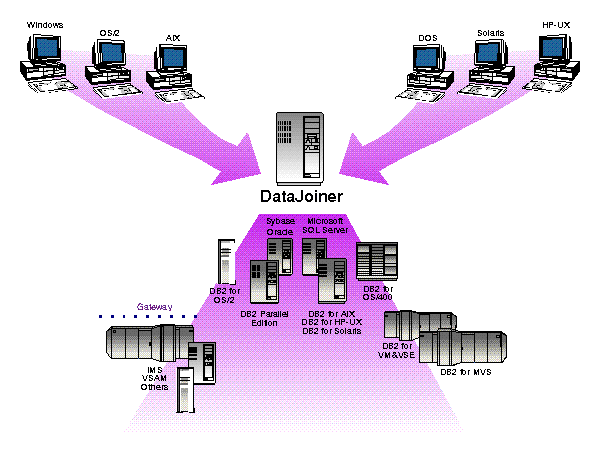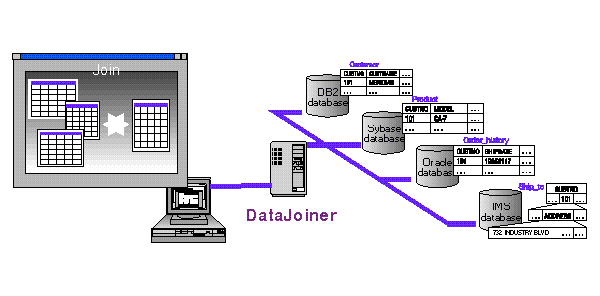

Table of contents:
Admit it. You have data scattered from here to there on sources that can't talk to each other. You can usually access the information you need everyday, along with the few items you need from time to time. But what about solving a really tough problem, one that requires you to pull information from a variety of sources all at once? It might be left alone, not because it's unnecessary, but because it requires droves of programmers to figure out where the information is located and how you can use it once you get it. Maybe you can't use it because your marketing department has Oracle but customer service uses DB2. Good luck.
Every organization from those in home offices to those in corporate headquarters searches for a competitive advantage. Finding daily operations data efficiently is no longer a competitive advantage. The best companies today can access any data they want, when they want it, and use it the way they need to. That's today's competitive advantage and one not to be overlooked. Ignorance might be bliss in poetry, but it's death in business.
That's why IBM developed DataJoiner. It's a new class of database middleware that lets you join data from different sources with a single SQL statement and a single interface. That single interface hides all the differences you struggle with when accessing information from around your business. Even your application doesn't have to know the differences. One interface to one database image. It's that simple. You don't even have to know where the data resides.

"Wow," you might say after reading all this, "that's just like having one big database." Exactly.

If you're impressed by how much DataJoiner can do, wait until you see how fast it can do it. IBM is known for its optimizer technology and DataJoiner development infused the company's most advanced techniques inside DataJoiner. Some middleware products have an optimization strategy that consists of materializing each of two tables to be joined on a platform containing the middleware code. The join occurs there. But wait a minute. Take a moment to consider that one of the tables might contain 5,000,000 rows, while the other might only contain 10,000 rows. Doesn't it make sense to just materialize the smaller table? It might. Better yet, perhaps only portions of each table need to be materialized. Some optimizers won't figure this out. Ours will.
Our optimizer doesn't just look at the number of rows in the two tables to be joined, nor is it satisfied with a simple index strategy. Instead, the DataJoiner optimizer takes into consideration the relative CPU speed of each data source, the relative IO speed, and the relative network bandwidth when formulating a fast solution to your query. It combines these factors with statistics you supply on each data source to blaze a path to the information you need.
DataJoiner's optimization strategy can lead to improvements measured in days, not hours or minutes. Think about that. DataJoiner could give you answers by lunchtime. Something else might not give you answers until you drive home that night, watch television, dream about your query, shower the next morning, eat breakfast, and drive back to work. Hope it wasn't urgent.
"Okay," you're thinking, "who can DataJoiner really talk to?" Glad you asked. DataJoiner supports relational and non-relational data sources, including:
Additionally, DataJoiner includes a generic access API that allows you to use existing drivers and/or create new drivers to gain access to an unlimited set of data sources.
DataJoiner supports a range of standards including ODBC and XOPEN CLI. Clients can access DataJoiner from any of the DB2 Client Application Enabler platforms such as OS/2, Windows, and UNIX. Also, you can use one of several popular programming languages like C, FORTRAN, and COBOL to take advantage of DataJoiner's single-database API.
DataJoiner works with hundreds of tools that support the IBM Client Application Enabler API. Now you can extend the power of familiar tools like Microsoft Access, IBM Visualizer, IBM Visual Age, and PowerSoft PowerBuilder to work with data across your business through the DataJoiner interface.
Want to learn how to use DataJoiner? We'll teach you all about it. IBM offers customer education for DataJoiner, with classes available now.
We can even come to your place to configure your existing systems and install DataJoiner. IBM offers two phases of DataJoiner consulting:

So that's DataJoiner. It accesses your data, IBM or non-IBM, relational or non-relational, local or remote, like it was all part of one big database. It makes your queries more powerful than ever, makes your application development easy, strengthens your replication strategy, and provides a full-strength relational database. And thanks to its intelligent optimizer, DataJoiner gets your work done in a hurry.
It's a whole new class of data access middleware.
For more information about DataJoiner, including information about education and services, contact your IBM authorized software reseller or IBM marketing representative.